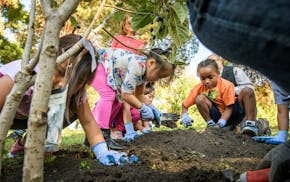CHICAGO – When doctors told Michelle Trujillo in July that her 6-year-old daughter would need a bone marrow transplant to save her life, the suburban Crystal Lake mother didn't want to wait another minute before getting her only child back to health.
But months later, Sophia — who has aplastic anemia, a rare disorder that impairs her immunity — is still waiting for a donor match. Meanwhile, Trujillo says she lies in bed at night making mental lists of places to try to find a donor with similar multiracial heritage to her daughter's — a group with a strikingly low match rate.
"I don't sleep at night. I think of, 'What can I do now? Who can I contact now?' " said Trujillo, whose daughter is half Filipino, as well as Irish, Spanish and Italian. "One match is all we need, but it's like a needle in a haystack."
The Trujillos' predicament highlights a nationwide paradox that has troubled medical experts and families awaiting transplants for years: Despite the ever-growing diversity in the United States, there are not enough minority and multiracial donors registered and available for patients in need. In the national bone marrow registry, Minneapolis-based Be the Match, 61 percent of the donors are white, 10 percent are Hispanic or Latino, 6 percent are black, 6 percent are Asian and just 4 percent are multiple races.
Given these numbers, the likelihood of matching a white patient with a donor is 97 percent. But the chances drop from there: Asians have an 84 percent chance of being matched; black patients have a 76 percent chance, according to Be the Match. And while numbers are not available for mixed-race matches, the odds of multiracial patients finding a match are considerably lower, said Lauren Johnson, community engagement specialist for Be the Match.
Marrow and cord blood contain certain genetic markers that are inherited, and combinations of those markers are more common in some racial groups than others. So, while not a guarantee, a donation from someone with similar racial heritage presents the best possible chance for transplant success, Johnson said.
This is different from the donor matching process for tissue transplants such as hearts, livers and kidneys, when race is not a key factor.
To address the shortage, officials from the national registry — along with hospitals, charity groups and families waiting for transplants — have worked to increase the number of minority and mixed-race donors over the last five years. Be the Match representatives have reached out to ethnic community leaders, church pastors, college fraternities and other groups in hopes of diversifying the donor pool, Johnson said.
Despite the efforts, however, growth in those groups remains slow, and medical professionals say the shortage will become more pronounced as the U.S. population gets even more diverse.
"There are people from all over the country, all over the world that are searching for any possible way to help their case — and they're desperate," said Athena Asklipiadis, founder of Mixed Marrow, a not-for-profit website for mixed-race patients in need of donors.
The group promoted the story of Sophia, whose heritage makes her difficult to match. While people of European ancestry tend to be matched quickly, the girl's half-Filipino side diminishes her chances, said Caitlin Agrawal, one of Sophia's doctors in the department of pediatric hematology/oncology at Advocate Children's Hospital in Park Ridge.
Bone marrow makes the components of blood — white blood cells that fight disease, and red blood cells that carry oxygen and platelets to help stop bleeding. When bone marrow becomes unhealthy, as it does with illnesses including leukemia, aplastic anemia and other genetic or immune diseases, a bone marrow transplant is often a patient's best chance for survival.
A little more than a year ago, Sophia was a seemingly healthy little girl who loved birthday parties, the color pink and singing along with the movie "Frozen." At her annual wellness check, Trujillo mentioned that Sophia seemed to bruise easily. Doctors noted that toddler bruising is common as children play, but they ordered blood tests to be safe, Trujillo said.
Test results detected aplastic anemia, which commonly appears in bone marrow around school age. Her faulty bone marrow stopped making blood cells, and symptoms of the illness — nosebleeds, dizziness and headaches — surfaced over the next year, Agrawal said.
Sophia's aplastic anemia, a life-threatening disease that is estimated to affect two in a million people, means her body stopped making platelets, white and red blood cells. Her body is unable to clot blood or fight even the common cold, doctors said.
Johnson of Be the Match said several misconceptions may have contributed to the slow growth in minority and mixed-race marrow donors. Some cultural groups have religious or superstitious hesitations about giving away a part of themselves. Others fear it's a painful or very involved process, she said. In actuality, donating bone marrow is often a simple process similar to giving blood, Johnson said.
In the meantime, Trujillo, an account manager for Eaglewood Resort and Spa in Itasca, has dedicated herself to finding her daughter's match. "When you look at her and how she's doing, there's no other way to be than to be strong with her," she said. "At night, I think, 'How am I going to save my kid? I need to save my kid somehow.' "

In Australia, 'cats are just catastrophic'
A climate-minded newcomer's guide to riding transit in the Twin Cities
Cyberattack hits New York state government's bill drafting office

Why you should donate clothing: It (probably) won't end up at the dump
